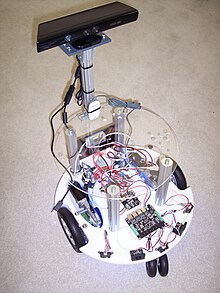 | |
| Developer(s) | Microsoft in association with the community |
|---|---|
| Initial release | December 18, 2006 |
| Stable release | 4.0
/ March 8, 2012 |
| Operating system |
|
| Type | Robotics suite |
| License | Various |
| Website | www |
Microsoft Robotics Developer Studio (Microsoft RDS, MRDS) is a discontinued Windows-based environment for robot control and simulation that was aimed at academic, hobbyist, and commercial developers and handled a wide variety of robot hardware. It requires a Microsoft Windows 7 operating system or later.
RDS is based on Concurrency and Coordination Runtime (CCR): a .NET Framework-based concurrent library implementation for managing asynchronous parallel tasks. This technique involves using message-passing and a lightweight services-oriented runtime, Decentralized Software Services (DSS), which allows orchestrating multiple services to achieve complex behaviors.
Features include: a visual programming tool, Microsoft Visual Programming Language (VPL) to create and debug robot applications, web-based and windows-based interfaces, 3D simulation (including hardware acceleration), easy access to a robot's sensors and actuators. The primary programming language is C#.
Microsoft Robotics Developer Studio includes support for packages to add other services to the suite. Those currently available include Soccer Simulation and Sumo Competition by Microsoft, and a community-developed Maze Simulator, a program to create worlds with walls that can be explored by a virtual robot, and a set of services for OpenCV.


